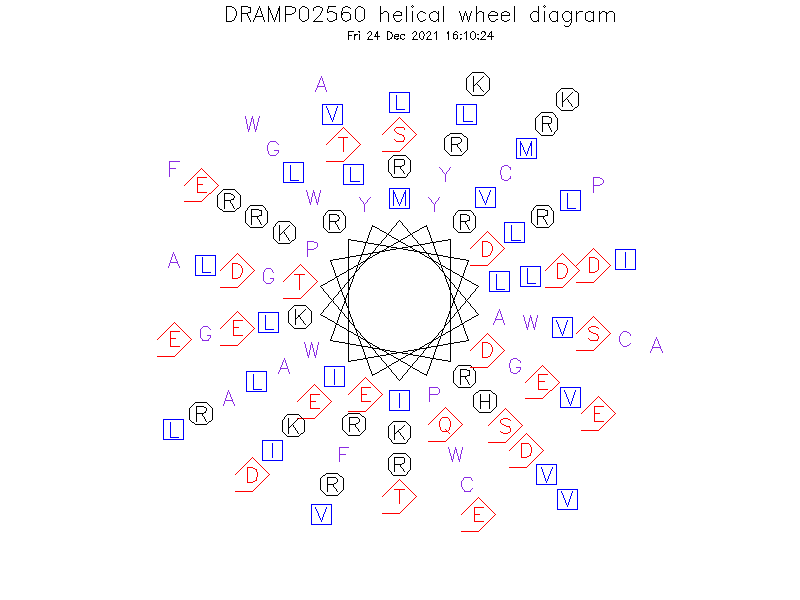General Information
-
DRAMP ID
- DRAMP02560
-
Peptide Name
- CRISPR-associated endoribonuclease Cas2 (Antiviral defensin)
-
Source
- Myxococcus xanthus (strain DK 1622)
-
Family
- Belongs to the CRISPR-associated endoribonuclease Cas2 prote
-
Gene
- cas2
-
Sequence
- MAEPRRWYLITYDIRDPKRWRKVHALLKGYGEWLQLSVFRCSLTDRDREKLRWELSRRMDAVDTLLVIGLCGGCVERVRAINAKEDWPEEPAPFKVL
-
Sequence Length
- 97
-
UniProt Entry
- Q1CW51
-
Protein Existence
- Transcript level
Activity Information
-
Biological Activity
- Antimicrobial, Antiviral
-
Target Organism
- No MICs found in DRAMP database
-
Hemolytic Activity
-
- No hemolysis information or data found in the reference(s) presented in this entry
-
Cytotoxicity
-
- Not included yet
-
Binding Target
- Metal-binding
Structure Information
-
Linear/Cyclic
- Not included yet
-
N-terminal Modification
- Not included yet
-
C-terminal Modification
- Not included yet
-
Nonterminal Modifications and Unusual Amino Acids
- Not included yet
-
Stereochemistry
- Not included yet
-
Structure
- Not found
-
Structure Description
- Not found
-
Helical Wheel Diagram
-
PDB ID
- None
-
Predicted Structure
- There is no predicted structure for DRAMP02560.
Physicochemical Information
-
Formula
- C521H825N151O139S5
Absent Amino Acids
- ?
Common Amino Acids
- RL
Mass
- 11588.51
PI
- 9.18
Basic Residues
- 20
Acidic Residues
- 15
Hydrophobic Residues
- 36
Net Charge
- +5
-
Boman Index
- -229.24
Hydrophobicity
- -0.483
Aliphatic Index
- 91.44
Half Life
-
- Mammalian:30 hour
- Yeast:>20 hour
- E.coli:>10 hour
Extinction Coefficient Cystines
- 32095
Absorbance 280nm
- 334.32
Polar Residues
- 18
DRAMP02560

Comments Information
Function
- CRISPR (clustered regularly interspaced short palindromic repeat), is an adaptive immune system that provides protection against mobile genetic elements (viruses, transposable elements and conjugative plasmids). CRISPR clusters contain sequences complementary to antecedent mobile elements and target invading nucleic acids. CRISPR clusters are transcribed and processed into CRISPR RNA (crRNA). Functions as a ssRNA-specific endoribonuclease (By similarity).
Induction
- Part of an operon going from at least MXAN_7266 to MXAN_7259 that includes a CRISPR operon with transcription continuing into the pre-crRNA locus.
Literature Information
- ·Literature 1
-
Title
- Evolution of sensory complexity recorded in a myxobacterial genome.
-
Pubmed ID
- 17015832
-
Reference
- Proc Natl Acad Sci U S A. 2006 Oct 10;103(41):15200-5.
-
Author
- Goldman BS, Nierman WC, Kaiser D, Slater SC, Durkin AS, Eisen JA, Ronning CM, Barbazuk WB, Blanchard M, Field C, Halling C, Hinkle G, Iartchuk O, Kim HS, Mackenzie C, Madupu R, Miller N, Shvartsbeyn A, Sullivan SA, Vaudin M, Wiegand R, Kaplan HB.
- ·Literature 2
-
Title
- Regulation of dev, an operon that includes genes essential for Myxococcus xanthus development and CRISPR-associated genes and repeats.
-
Pubmed ID
- 17369305
-
Reference
- J Bacteriol. 2007 May;189(10):3738-3750.
-
Author
- Viswanathan P, Murphy K, Julien B, Garza AG, Kroos L.

